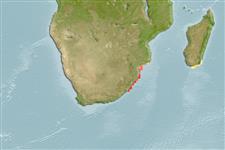分類 / Names
俗名 | 同種異名 | Catalog of Fishes(屬, 種) | ITIS | CoL | WoRMS | Cloffa
Teleostei >
Eupercaria/misc (Various families in series Eupercaria)
鱸形目 (Various families in series Eupercaria) >
Labridae (Wrasses)
隆頭魚科 (Wrasses) > Corinae
Etymology: Halichoeres: Greek, als, alis = salt + Greek, choiros = pig (Ref. 45335); zulu: Named for the indigenous people of the Province of Kwazulu-Natal, South Africa..
More on authors: Randall & King.
Environment: milieu / climate zone / depth range / distribution range
生態學
海洋 礁區魚類; 深度上下限 0 - 2 m (Ref. 83900).
Western Indian Ocean: South Africa.
大小 / 重量 / 年齡
Maturity: Lm ? range ? - ? cm
Max length : 13.5 cm SL 雄魚/尚未辨別雌雄; (Ref. 83900); 7.9 cm SL (female)
簡短描述
檢索表 | 型態特徵 | 形態測量圖
背棘 (總數) : 9; 背的軟條 (總數) : 11; 臀棘: 3; 臀鰭軟條: 11. This species is characterized by the following: D IX,11; A III,11; pectoral rays 14 (rarely 13); 26 lateral line scales; naked head with no small scales on opercle or behind eye; narrow median dorsal zone of nape naked; 7 prepelvic scales, anterior third of chest naked; 3-5 tubule branches on lateral line scales; 11-15 suborbital pores; 19-21 gill rakers; body depth 2.95-3.6 in SL; caudal fin slightly rounded, 1.4-1.45 in HL; preserved color of female pale tan, the scales on upper two-thirds of body, posterior to pectoral fins, with brown centers, those below soft portion of dorsal fin and in lowermost row dark brown; 3 broad dusky bars on chest and abdomen, fading ventrally; opercular flap at upper end of gill opening with a black spot shaped like an inverted comma; usually present behind upper part of orbit is a dark brown spot of near-pupil size; snout with an oblique dusky band; across cheek and opercle is an elongated, dark-edged, horseshoe-shaped band; oblique brown bands on dorsal fin with a small black spot on first membrane and an ocellated black spot between second and fourth dorsal soft rays; small dark spots on caudal fin rays; similar basic color pattern in male, but most markings are darker; no black spot anteriorly on dorsal fin and no oblique bands in spinous portion; base of anal fin with a wavy dark band and a pale spot at base of each membrane. In life, females are mainly pink or lavender-pink, with narrow pale green bands, a bright red stripe on nape, extending below base of spinous portion of dorsal fin, a row of small dark brown spots on side of body above anal fin; males with deep pink and bright green bands on head, with alternating wavy stripes of bright green and purplish red on body (Ref. 83900).
A rare species with paucity of specimens, this is partly due to its misidentification as Halichoeres nebulosus, its usual shallow-water habitat off exposed rocky shores where it is difficult to collect and its being very elusive. Found on rocky bottom or sand with scattered patches of reef at depths of 0.5-1.5 meters. A male individual was photographed from a pool (about 5 m long, 2 m wide and 1.2 m deep) almost close to the sea at low tide (Ref. 83900).
Life cycle and mating behavior
Maturities | 繁殖 | Spawnings | Egg(s) | Fecundities | 仔魚
Distinct pairing during breeding (Ref. 205).
Randall, J.E. and D.R. King, 2010. Halichoeres zulu, a new labrid fish from South Africa. Smithiana Bull. 11:17-23. (Ref. 83900)
人類使用
工具
特別的報告
下載 XML
網路資源
Estimates based on models
Preferred temperature (Ref.
123201): 23.6 - 25.4, mean 24.9 °C (based on 27 cells).
Phylogenetic diversity index (Ref.
82804): PD
50 = 0.5000 [Uniqueness, from 0.5 = low to 2.0 = high].
Bayesian length-weight: a=0.00955 (0.00451 - 0.02020), b=3.09 (2.92 - 3.26), in cm total length, based on LWR estimates for this Genus-body shape (Ref.
93245).
營養階層 (Ref.
69278): 3.5 ±0.5 se; based on size and trophs of closest relatives
回復力 (Ref.
120179): 高度, 族群倍增時間少於 15個月 (Preliminary K or Fecundity.).
Fishing Vulnerability (Ref.
59153): Low vulnerability (10 of 100).
